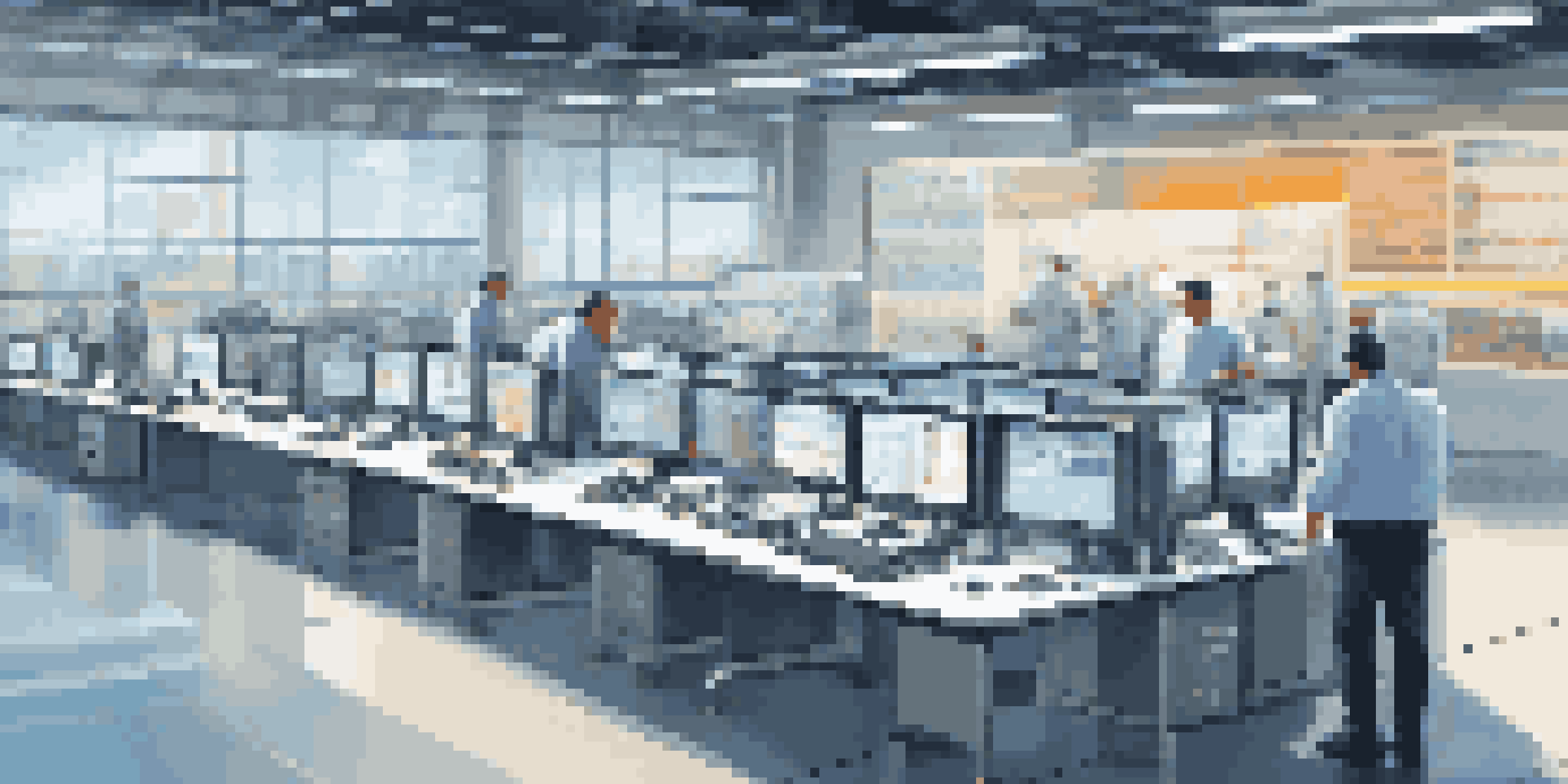Remote Monitoring Solutions for Manufacturing Efficiency

Understanding Remote Monitoring in Manufacturing
Remote monitoring in manufacturing refers to the use of technology to observe and control processes without being physically present. This can include monitoring machinery, production lines, and even supply chains through various sensors and software solutions. The rise of IoT (Internet of Things) has made it even easier to implement these systems, allowing real-time data collection and analysis.
In the age of technology, the future of manufacturing is not about machines, but about how we leverage data from those machines.
By harnessing remote monitoring, manufacturers can gain insights into their operations that were previously difficult to attain. For instance, they can track equipment performance, detect anomalies, and even predict maintenance needs before issues escalate. This kind of proactive management not only saves time but can significantly reduce downtime and associated costs.
Overall, understanding remote monitoring is crucial for manufacturers looking to enhance their efficiency. It’s not just about keeping an eye on operations; it’s about leveraging data to make informed decisions, optimize processes, and ultimately drive profitability.
Key Benefits of Remote Monitoring Solutions
The primary benefit of remote monitoring solutions is the ability to boost operational efficiency. By continuously tracking equipment health and production metrics, manufacturers can identify bottlenecks and streamline workflows. This leads to faster production times and improved quality, making the entire manufacturing process more efficient.

Additionally, these solutions enhance decision-making capabilities. With real-time data at their fingertips, managers can make quick, informed decisions that keep production running smoothly. For example, if a machine is operating below optimal levels, adjustments can be made immediately, preventing potential losses in productivity.
Boosting Efficiency with Data
Remote monitoring enables manufacturers to track performance and optimize processes, leading to enhanced operational efficiency.
Finally, remote monitoring contributes to cost savings. By reducing downtime and minimizing maintenance costs through predictive analytics, manufacturers can allocate resources more effectively. This financial benefit is often one of the most compelling reasons for companies to invest in these solutions.
How Remote Monitoring Increases Productivity
Remote monitoring increases productivity by providing manufacturers with immediate feedback on their operations. This instant access to data allows teams to respond swiftly to any issues that arise, maintaining a steady workflow. For example, if a machine shows signs of wear, operators can intervene before it causes a halt in production.
The ability to monitor and manage operations remotely is not just an advantage; it's a necessity in today's competitive landscape.
Moreover, it enables more efficient resource management. By understanding how resources are being utilized in real-time, manufacturers can optimize their usage. This might mean adjusting staffing levels based on production needs or reallocating materials to where they’re most needed, leading to a leaner operation.
Ultimately, the combination of immediate feedback and efficient resource management translates to higher productivity levels. Manufacturers can produce more with the same resources, which is a win-win situation for both the business and its employees.
Real-World Examples of Success
Several leading manufacturers have successfully implemented remote monitoring solutions. For instance, a major automotive manufacturer utilized these systems to monitor their assembly lines. By analyzing performance data, they reduced production bottlenecks by 30%, leading to significant gains in overall efficiency.
Another example comes from a food processing company that integrated remote monitoring to track temperature and humidity levels in real-time. This not only ensured product quality but also allowed them to meet safety regulations more effectively, ultimately enhancing their brand reputation.
Cost Savings Through Predictive Tools
By reducing downtime and maintenance costs, remote monitoring solutions contribute significantly to financial savings for manufacturers.
These success stories illustrate that remote monitoring is not just a theoretical benefit; it’s a practical solution that can yield tangible results. Manufacturers who adopt these technologies often find themselves at the forefront of their industry.
Challenges in Implementing Remote Monitoring
While the benefits of remote monitoring are clear, there are challenges in its implementation. One significant hurdle is the initial investment in technology and training. Companies must be prepared to allocate resources toward the necessary infrastructure and ensure that staff are equipped to use these new tools effectively.
Data security is another concern. As manufacturers increasingly rely on connected devices, they must also protect their systems from cyber threats. Implementing robust cybersecurity measures is crucial to safeguard sensitive information and maintain trust with customers and partners.
Lastly, change management can pose a challenge. Employees accustomed to traditional methods may resist adopting new technologies. It’s essential for manufacturers to foster a culture of adaptability and provide adequate training to ease this transition.
Future Trends in Remote Monitoring Solutions
The future of remote monitoring solutions looks promising, with advancements in AI and machine learning expected to play a significant role. These technologies will enable more sophisticated data analysis, allowing manufacturers to not only monitor but predict future trends and behaviors in their operations.
Additionally, as 5G technology continues to roll out, remote monitoring will become even more efficient. Faster internet speeds will allow for real-time data transmission with minimal delays, enhancing the responsiveness of monitoring systems across the board.
Overcoming Implementation Challenges
Manufacturers face hurdles like initial investment and data security, but with proper planning and training, these can be effectively managed.
Finally, we can expect a greater emphasis on sustainability. Manufacturers are increasingly looking to monitor their environmental impact, and remote solutions can help track energy usage, waste production, and other key sustainability metrics, leading to greener operations.
Getting Started with Remote Monitoring Solutions
For manufacturers looking to implement remote monitoring, the first step is assessing their specific needs and goals. Understanding what areas of operation could benefit most from monitoring will help in selecting the right solution. This might involve consulting with experts in the field or conducting a thorough internal audit.
Once manufacturers have a clear picture of their needs, the next step is to choose the right technology and partners. There are many providers offering various solutions, so it’s essential to evaluate them based on features, scalability, and support. A tailored approach ensures that the selected system aligns with the company’s long-term vision.

Finally, training employees on the new system is crucial for successful adoption. Providing ongoing support and fostering an environment of continuous learning will help teams maximize the benefits of remote monitoring, ultimately leading to improved efficiency and productivity.